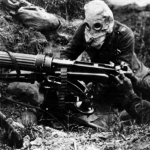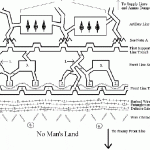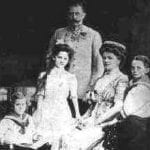The best way to describe the Third Ypres (Passchendaele) Campaign of 1917. It’s ‘slog.’ When you think about a drudging act that seems to accomplish nothing, this battle is it. Mud. Mud to your waist. Everything sinks down several feet into mud. Tanks, Cars, guns, horses, everything stuck in mud. Images of a battlefield landscape with pockmarked holes and mist rising from the plains with shattered trees is characterized by the third battle of Ypres.
The battle took place on the Western Front from July to November 1917 over control of ridges near the Belgian city of Ypres in West Flanders.
Private R.A. Colwell described the scene in 1918 as follows: “There was not a sign of life of any sort. Not a tree, save for a few dead stumps which looked strange in the moonlight. Not a bird, not even a rat or a blade of grass. Nature was as dead as those Canadians whose bodies remained where they had fallen the previous autumn. Death was written large everywhere.”
- I. The Western Front, January – June 1917
- a. In February 1917, the British and French made minor gains against the Germans.
- b. On April 4, the British began barraging Arras in preparation for a planned attack on Arras.
- c. 5 days later, the British launched an assault that began the Battle of Arras. A Canadian force captured Vimy Ridge.
- d. The French attacked also on April 16, beginning the Second Battle of the Aisne (The “Nivelle Offensive”). The French used tanks for the first time, but they were ineffective. The French were turned back and took 96,000 casualties. The attack was called off on the 20th. The morale of the French soldiers decreased. The offensive lasted until late May. (Part of the reason for the French defeat was the new German defensive doctrine of Eingrief (“counterattack” or “lock in”).
- e. On the 23rd, the British attacked (Battle of the Scarp), without success. Over the next few days, both British and French forces continued to attack the German lines with little success.
- f. On April 28, the French Minister of War appointed Phillipe Petain as Chief of Staff of the French army and asked Nivelle to resign. Nivelle refused.
- g. In April and May, small numbers of French units mutinied.
- h. On May 4 and 5, British and French forces made gains. But British casualties were up to 4000 per day (the highest daily rate throughout the war).
- i. In several locations in late May, French troops mutinied. They agreed to man the trenches, but they refused to attack. Many mutineers were arrested, and some were executed.
- II. Background to Third Ypres
- a. In the spring of 1917, General Douglas Haig, Commander of the First British Army, began planning an offensive centered around Ypres. Top naval commanders supported this idea, because they believed Ypres was the one place where their naval guns could support the infantry.
- b. The navy had been planning an amphibious assault for quite some time, even constructing floating docks.
- c. Haig hoped to combine an amphibious assault with a land assault, hitting the Germans from two directions. But the amphibious assault could not occur until a breakthrough on land did.
- d. Haig decided the amphibious assault would get the go-ahead when the British took the town or Roulers (10 miles inside German lines).
- e. The weather would be key. Flanders is flat, with a high water table. Haig’s staff read weather reports going back 80 years and concluded that “…in Flanders the weather broke early each August with the regularity of the Indian monsoon.” Haig was determined to get started before August.
- f. Haig hoped to take one salient to use as a forward staging point.
- g. The British had been digging tunnels since 1915. 19 were finished and packed with explosives.
- III. The Battle of Messines
- a. The British , led by General Herbert Plumer, began with a week-long artillery barrage, the heaviest in history to that point. Plumer had one gun for every 7 meters of front.
- b. On June 17, all of the mines in the underground tunnels were detonated. The blast was so powerful that it was felt as far away as London. One soldier later wrote that “the whole earth seemed to rock and sway…several of the men and myself being thrown down violently. It seemed to be several minutes before the earth stood still again…Flames rose to a great height…silhouetted against the earth I saw huge blocks of earth that seemed to be as big as houses falling back to the ground. It was awful, a sort of inferno.”
- c. About 10,000 German soldiers were immediately killed. 7000 were taken prisoner, and thousands others were stunned.
- d. The British took possession of a group of craters over 6 feet deep. But the British only penetrated a mile or so into German territory. Some scholars believe the British missed an opportunity to push further.
- IV. Third Ypres: Preparations
- a. Meanwhile, the British continued preparations for the planned amphibious assault. But the Germans, using observation balloons, were aware of what the British were doing.
- b. On July 10, the Germans launched “Operation Beach Party,” driving the British back westward, away from their planned landing site. In this attack, they used “Blue Cross” gas, which was designed to irritate enemy soldiers so much that they would tear off their gas masks. Soon afterward, they began using mustard gas.
- c. In late July, the British began an artillery barrage and set the date for a ground assault for July 31. The German position to be attacked was Passchendaele. It was on high ground, and there was no cover (all vegetation had been destroyed). The drainage system was destroyed, so any rain would turn the ground into muck.
- d. The Germans had only 1500 heavy guns to 2300 for the British. But their defenses were extremely strong. Keegan: “The completed Flanders Position was actually nine layers deep: in front, a line of listening posts in shell holes, covering three lines of breastworks or trenches in which the defending division’s front-line battalions sheltered; next a battle zone consisting of machine-gun posts, supported by a line of pillboxes; finally, in the rearward battle zone, the counter-attack units of the division sheltered in concrete bunkers interspersed between the positions of the supporting artillery batteries” (358).
- e. On July 26, the British sent 700 planes into the air. They quickly gained air superiority.
- V. The Battle Begins
- a. At 3:50 AM on July 31, the Allies began a creeping barrage. The infantry then went over the top across a 25 km front. There were a half million men attacking, along with 136 tanks.
- b. The attackers initially made good progress. The German front lines had largely been destroyed by the artillery.
- c. Before long, however, the tanks became bogged down. The attackers were slowed by the mud. Many men sank to their waists.
- d. German counter attacks soon halted the Allied advance.
- e. By late afternoon, the battle halted, but it was renewed the next day, and the British made more progress. After that, the rain prevented any further operations.
- f. British casualties were 31,000 from July 31 to August 3.
- VI. Subsequent Attacks: August – November
- a. On August 10, the British launched another attack, but it failed.
- b. Another attack on the 16th succeeded but was eventually stopped.
- c. A Canadian attack on Hill 70 (designed to pull German troops away from Ypres) in mid-August gained most of its objectives. The French army launched another diversionary attack at Verdun. The attack ended in mid-September.
- d. On August 22, the British advance had slowed to a crawl. By then, they had advanced only about 2 miles, one-half of the first day’s objective.
- e. On September 20, the British launched a new assault under the command of General Harold Plumer, beginning with a barrage that would include 3.5 million shells. The infantry then attacked, pushing the Germans back and taking many pillboxes. This caused a crack in the Hindenburg Line.
- f. On the 26th, Plumer’s Second Army again attacked at Polygon Wood. The British took several more German strongpoints, but they also lost thousands of casualties. The Germans began to worry.
- g. On October 4, the British attacked again (Battle of Broodseinde). They advanced nearly one kilometer while inflicting 30,000 German casualties (suffering 25,000). The German leadership began rethinking its entire defensive strategy.
- h. Intense rain turned the front into mud, but Haig ordered an assault for October 12 anyway. Not surprisingly, the attack failed.
- i. By mid-October, British casualties at Third Ypres were about 150,000, while the Germans had lost about 250,000.
- j. Between October 23 and 26, the French army gained about 6 miles at La Malmaison.
- k. In early November, Canadian forces took the village of Passchendaele and the ridge nearby. This is considered the end of the battle.
- VII. Results
- a. In all, the Allies gained about 5 miles of ground at the cost of 70,000 dead and 170,000 wounded. The Germans had 83,000 killed, 250,000 wounded and lost 26,000 POWs. Many of the British dead drowned in shell holes.
- b. Haig’s reputation was damaged. He has been widely criticized for not stopping the attack after Broodseinde. Keegan: “On the Somme [Haig] had sent the flower of British youth to death or mutilation; at Passchendaele he had tipped the survivors into the slough of despond” (369).
- c. British morale, both at home and on the front, plummeted.
Cite This Article
"Battle of Passchendaele" History on the Net© 2000-2024, Salem Media.
July 27, 2024 <https://www.historyonthenet.com/battle-of-passchendaele>
More Citation Information.









